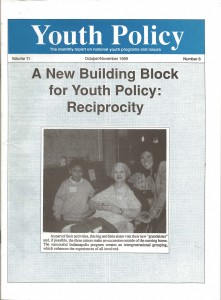 It is not news to the youth-serving community that something new is afoot regarding how we think about and work with youth.
It is not news to the youth-serving community that something new is afoot regarding how we think about and work with youth.
Well known is the stir on the national level: President Bush’s YES initiative; numerous pieces of congressional legislation whose proposals range from school-based programs through conservation and urban corps to mandated national service. Locally, projects of various sorts are springing up in schools, youth-serving agencies and in other organizations whose functions impinge on youth.
Not so well known-or fully understood-is a key notion that could well be lost amid the legitimate clamor and enthusiasm for the concept, namely, that youth service is not simply a program. It is infinitely more powerful, for it is also a perspective. And its implications are dual: first that we view youth in a new and fresh way, as a potential resource and not just as a tangle of pathology to be sorted out; and second, that all agencies which work with youth can become involved. Additional resources are helpful but not in all cases are they necessary. Most agencies working with young people can shift policy and practice to embrace a youth-as-resources dimension. Thus, it is both a program and a perspective.
Our methods of identifying and diagnosing the pathologies of youth are finely honed; good thing, for many adolescents need the best in services. However, our tools for eliciting and channeling strengths and talents are either blunt or non-existent. A change in perspective will help create better tools. And for those adolescents who do not need services, won’t we dignify them by asking for something in return?
We should challenge our teenagers, make them feel a part of their communities and channel their energies toward positive ends. Given the opportunity for responsible, useful involvement and the chance to contribute, the great majority will acquire a stake in their communities that will help them mature into successful adults. What’s needed is a message to all kids that they are responsible and essential members of society.
This idea-utilizing youth as community resources works with those who are in trouble as well as those who aren’t; with loners as well as kids who socialize well; with the average or below-average as well as those who are headed for college.
The concept is more than community service. As valuable as that is, it treats the young as little more than volunteers whose roles are pre-defined. The young people themselves should be involved in determining need, ‘/ designing projects and programs, executing plans and evaluating projects.
The approach works in part precisely because it is aimed at everybody. It is not a delinquency prevention program, not a structured membership, and not labeled as anything other than young people getting important things done that need doing. It is not the last step before prison.
Perhaps precisely because it is not pejorative, the idea has engaged and transformed some young people who are already in trouble or headed that way. An example:
–I’ve helped clean up the yards of my seniors. I help them go shopping. I even read to them. Do you know, it’s the first time in my life I’ve ever been thanked?” -Earl, 16, probationer, Indianapolis.
The social dynamics of our time require an approach of this sort Youth mature physically earlier and earlier, but they’re denied social and economic maturity until later and later. Although they seek to grow beyond the confines of family and close friends, teenagers have been refused a place in the community, a sense that they have a legitimate role and stake in the larger social framework. The trend has been exacerbated by a variety of forces: increased demographic mobility, anonymous neighborhoods, a dramatic increase in single-parent and two-earner families.
Even when young people are forced by circumstances to cope with heavy adult burdens, we perceive them as abnormal, somehow robbed of a “happy childhood.” We fail to recognize their ability to become responsible members of the community and see them instead as an aberration.
As society is not structured, no social mechanism works for the positive, non-traumatic integration of young people into the adult world. Few help them achieve a civic-as opposed to personal-maturity, a realization that they benefit from, and in turn can benefit, the community. These ideas are manifested concretely in a program designed by National Crime Prevention Council and funded by the Lilly Endowment, whose project officers, Joan Lipsitz and Willis Bright, have had a major hand in helping to guide the project, a two and one-half year effort” in the Indiana cities of Evansville, Ft. Wayne, and Indianapolis.
Initial results in all three Indiana cities are striking. Young people are gaining enthusiastic backing from adults who were at best mildly supportive. More than 1,500 teens and pre-teens have completed more than 150 projects that have enhanced their schools communities. Projects have arisen from community board-approved grants ranging from $500-$2,000 range. All involve teens in responsible roles as program developers as well as project participants.
Diversity in kids abounds. The mix includes teen mothers putting on plays for elementary school students about what it means to be a teen mother, juvenile delinquents, scouts, church groups, school groups, 4-H members, and dropouts. The projects, too, are diverse: outings for children in battered women’s shelters; companion service for the elderly; cleanups of entire neighborhoods; construction of housing for low- income families; mentoring of kids in foster care; youth proving dramatically that they can participate in all of the difficult social issues confronting the adult society-literacy, housing, teen pregnancy, AIDS, etc.
And who benefits? Parks, which get facelifts and new facilities, the criminal justice system, the elderly, children, pre-teens, housing authorities, and more. Best of all, young people, as our research is showing, develop a stronger sense of self-esteem, worth, a more positive perception of their role in community, an increased sense of their own abilities to tackle some of society’s most vexing issues, and a growing sense of their own potency as leaders.
In carrying out these projects, these young people learn a great deal. They learn about themselves, about their community, about potential careers, about relationships, about citizenship at its most basic.
Emerging Trends
Youth as Resources is being evaluated by universities in each of the three sites. They are looking at the effect of Youth as Resources from three angles-on participating youth, on the host agencies, and on the beneficiaries of youth service.
While the data is both young-not definitively interpreted-and incomplete, hints of exciting if not profound changes are identifiable. Youth tended to feel more confident and competent, more needed, and they have discovered their leadership qualities; direct interaction with beneficiaries is critical (i.e., it is not enough simply to make toys for retarded children, but make the toys and deliver them, experiencing the reaction of the benefiting children); tangible rewards such as pizza, trips and T-shirts are not that important, whereas teamwork, and a sense of accomplishing an important mission are; results cut across social, economic, race and status lines, from the delinquent to the college-bound; intensity and duration of projects stand as critical variables (more work done over a longer period of time produces greater change in youth and the host agency).
Host agencies were not merely passive conduits for the program. They too were affected: some continued the program after the expenditure of Lilly monies; some put teens on their board of directors; some hired staff to work on similar types of programs. And almost all beneficiaries from battered women to the elderly expressed deep appreciation for (and in some cases a dramatically altered attitude toward) the work teens had done.
At Risk Kids; Risky Projects
If these preliminary findings stand up over time (the final report is due in March, 1990), the implications for youth-serving agencies are significant. First of all, it means that all organizations with minor shifts and policy in practice can participate from the traditional to the new. The list of participating agencies is long and varied including such organizations as: youth shelters; churches; probation; elementary, middle, and high schools; Boys and Girls Clubs; Urban League; museums; employment/ training centers; Big Brothers/Big Sisters; Boy Scouts and Girl Scouts; community choirs; Catholic Youth Organizations; social services; Visiting Nurses; 4-H; Red Cross; and mental health centers.
This would seem to imply that “traditional agencies” serving youth can expand their mission from basic services to youth to partnering with youth to help address any issue about which society is concerned (e.g., child abuse, teen pregnancy, literacy, housing, etc.); and that for agencies who are looking for ways to expand their missions (and/or the types of youth served) Youth as Resources provides a marvelous vehicle.
This also means that agencies which tend to serve youth who are not in trouble can without a great deal of difficulty reach out to at-risk kids, serving them in programs such as this.
Program and Perspective
Youth as Resources is a view, an outlook, an ethos in which other programs can participate. It must not be seen simply as a grantmaking mechanism or a program. It concerns the ways in which those who work with youth- in a community service organization, a school group, a social work agency or anywhere else-perceive them.
 Youth as Resources programs and similar projects run counter to current notions. The deficit model sees young people as objects, not subjects; as in need of fixing, not capable of giving. While we must heal those who are wounded, we must realize that all want to give and need to give-even the wounded. Although some youth specialists have eked the tide to take a positive view, the substantial majority have focused on programs directed at and for youth not with and by them.
Youth as Resources programs and similar projects run counter to current notions. The deficit model sees young people as objects, not subjects; as in need of fixing, not capable of giving. While we must heal those who are wounded, we must realize that all want to give and need to give-even the wounded. Although some youth specialists have eked the tide to take a positive view, the substantial majority have focused on programs directed at and for youth not with and by them.
Our policies for youth are invariably framed in terms of assistance or control. We believe strongly that such policies both narrow our thinking about the potential of these youth and narrows the size of the constituency of those concerned about them.
The new policy formulation would need assistance with obligation (reciprocity), thereby broadening the public’s vision of youth’s potential and enlarging the constituency of those advocating for their welfare.
Giving young people, including those on society’s edge, a stake in their communities can turn the “youth problem” on its head. The ultimate goal: to change the way in which our country regards and uses the skills of its youth, so that young people are not viewed primarily as service objects but as service actors with significant roles to play.
* Originally printed in the October/November 1989 edition of Youth Policy, a publication of the Youth Policy Institute.



Leave a Reply